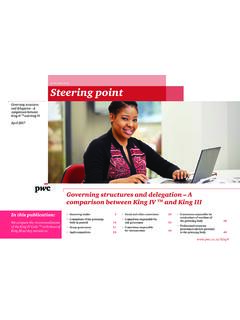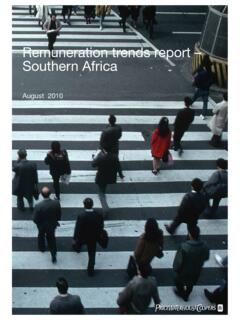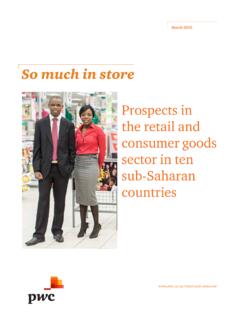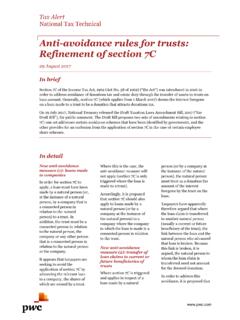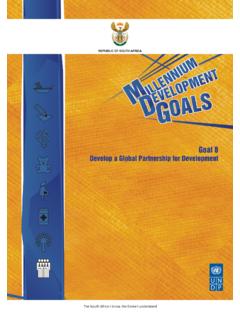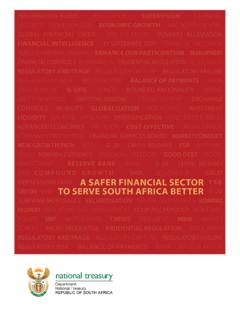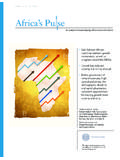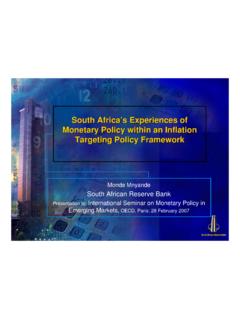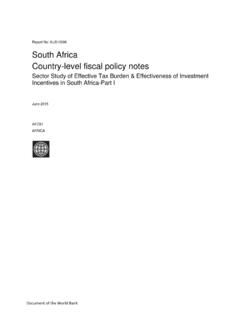Transcription of Strengthening Africa’s gateways to trade - pwc.co.za
1 An analysis of port development in sub-Saharan africa April 2018 Strengthening africa s gateways to africa s gateways to tradeAbout this reportThis report was compiled by PwC s Capital Projects and Infrastructure (CP&I) Transport and Logistics team using a combination of information obtained from interviews with port authorities and port operators, together with detailed research and incorporating our extensive knowledge of the port, trade and transport report makes reference to countries in sub-Sahara with ports. For the purposes of this report these countries have been categorised into the regions of East africa , West africa , Islands and Southern CongoCameroonNigeriaBeninTogoGhanaC ted IvoireLiberiaSierra LeoneGuineaSenegalGambiaGuinea BissauGabonCongoAngolaMozambiqueNamibiaB otswanaSouthAfricaMadagascarMauritiusCom orosSeychellesCabo VerdeSomaliaDjiboutiTanzaniaEquatorial GuineaEast AfricaIslandsSouthern AfricaWest AfricaAcknowledgementsThis report was prepared by Dr Francois Botes (PwC transport & logistics and ports subject matter expert) and Stacey Buck (Senior Manager: Capital Projects and Infrastructure) under the direction of Dr Andrew Shaw ( africa Transport and Logistics Leader).
2 We thank those who contributed data, insights and analysis to the development of this report. In particular, we would like to thank the following for their time and insights: Lars Greiner independent consultant to PwC and Ports specialist Martin Diebel Liz Whitehouse and team from africa House BMI Research A Fitch Group Company Lullu Krugel and the PwC economics team Catherine Ensor and the PwC design teamWe also thank those interviewees who shared their views with , despite its enormous size, still represents only a small portion of world trade . Exports are largely commodity based and include oil, coal, iron ore, ferrochrome, precious metals, cocoa, palm oil and timber. Yet, africa is growing and many of its larger economies are beginning to diversify away from a traditional commodity focus. Ports represent the gateways for these commodity exports, but as countries grow and develop, ports are also essential for sustaining and improving more robust and diverse growth in African economies through the import and export of manufactured goods and other products.
3 Ports are a vital part of the supply chain in africa with each port having a far-reaching hinterland often spanning a number of countries. Ports have thus become a natural focus for regional number of global port logistics trends have emerged in the last decades, including the emergence of hub ports, which facilitate dominant volumes of global trade in and out of a region. In africa , the trend is gathering some momentum but is constrained by lower volumes of cargo relative to other parts of the world, poor port performance, hinterland dominance focused on certain ports, and global shipping routings that have not replicated the hub-and-spoke model more commonly found in other parts of the trends such as improved intermodal facilities, enhanced back-of-port logistics and closer linkages to railway networks are common but are also less well developed than in other parts of the world.
4 A number of corridor-based initiatives focused on improving the hinterland flow of goods both by road (the dominant mode) and by improvements in the railway network can be found across africa and these are tending to focus on the higher-volume ports. Examples include improvements to the Gauteng-Durban corridor, initiatives to enhance trade between Rwanda, Burundi and Dar es Salaam and between Uganda and Mombasa. In the west similar trends are emerging between the landlocked countries of Mali, and Burkina Faso, and the Ports of Tema, Abidjan and Dakar. africa s trade with China is growing. China imports commodities such as oil, iron ore, copper and other metal ores from africa and as the region has developed, China has benefitted from exporting growing volumes of mostly manufactured products. China has also become a significant investor in African infrastructure projects and our research has identified increasing opportunities for China to play a stronger role in port believe that the global transportation and logistics industry can no longer afford to ignore developments in africa and that logistics service providers and ports in particular, will continue to play a key facilitating role in enabling economic growth across sub-Saharan africa .
5 Dr Andrew ShawPwC africa Transport & Logistics LeaderManish R Sharma PwC India Port Centre of Excellence and Transport & Logistics LeaderJulian SmithPwC Global Transport & Logistics LeaderStrengthening africa s gateways to tradeForewordGlobal production networks will increasingly drive port efficiency to integrate all components of the global logistics and supply chains. Ports will therefore come under increasing pressure to respond to the needs of shipping lines, logistics providers and multinational manufacturers as they seek to drive efficiencies throughout the value chain. Ports investment decisions, which in the past have been driven largely by supply-side factors, are likely to be increasingly dictated to by demand-side remains a strong case for africa to focus on investment in ports. Developing port infrastructure ahead of demand, focusing on the ports with the greatest volume potential (the hub ports of the future) and improving their overall functioning so that through productivity gains they are increasingly attractive as destinations for global trade .
6 Increased volumes of trade and more productive and attractive ports will accelerate changes in global shipping routes serving africa . As in other Dr Andrew Shaw PwC africa Transport & Logistics LeaderManish R Sharma PwC India Port Centre of Excellence and Transport & Logistics Leader Julian Smith PwC Global Transport & Logistics Leaderparts of the world, this will lead to increased integration with global shipping and trade routes, partly through the allocation of larger vessel sizes reducing transit times and reducing the unit cost of transport to and from the you represent government, port authority, port operator, shipping line or logistics provider, we are hoping that our assessment of sub-Saharan ports will help you better understand where the greatest opportunities lie in these rapidly-changing gateways to africa . PwCContents1. PwC s blueprint for sub-Saharan port investment 22.
7 The African context 133. Volumes 184. Port performance 265. Liner shipping changing port infrastructure needs 456. Future drivers of investment 537. Moving forward: Summary of conclusions 658. PwC s transport, logistics and ports expertise and services 709. Continuing the conversation 72 Appendices A Hub attractiveness score 76B Sub-Saharan GDP growth data 78C: Port Performance Ratings 80 Strengthening africa s gateways to trade21. PwC s blueprint for sub-Saharan port investmentThe case for shifting focus Sub-Saharan africa (SSA) has been on a strong, sustained growth trajectory since the late 1980s. growth is forecast to pick up from in 2017 to in 2022, and is predicated on commodity exports and rapidly transforming While many of these economies are growing from a small and often fragile base, it is clear that growth is being led by africa s trade access to large global users of natural resources.
8 Ports provide a gateway to this African trade . Their competitiveness and positioning in global supply chains defines africa s ability to export and improving imports sustains greater economic resilience. Facilitating improvements in African trade through ports is complex. Ports are often fed by inland corridors that have their own infrastructure, delay and cost issues. Many African countries have no direct access to the sea. 1 International Monetary Fund, World Economic Outlook Database, October 2017. the way ports are run and managed, creating greater capacity and reducing delays to shippers is key to making ports more efficient. This is key to reducing the overall cost of logistics and improving reliability of goods in transit. There has been a lag in port investment, with port expansion and expenditure on port assets often not keeping pace with trade growth .
9 Together with poor operational performance this creates a bottleneck to economic growth , increasing logistics costs, reducing reliability and making African countries less globally competitive. A further challenge for African ports is that shipment sizes are small compared to those globally, driving up the unit cost of a shipment. This means moving a single container (or any other unit of volume) is to times2 more expensive from africa than for high-volume trade routes over a comparable Based on quotes that PwC received from international PwC s blueprint for sub-Saharan port investmentThis report was developed in response to the challenges facing sub-Saharan africa s ports in attracting sufficient external investment. The remainder of this chapter outlines a blueprint for ports investment based on our analysis of each of the identified issues: Section 2 contextualises why ports matter and how they facilitate trade and regional integration.
10 Section 3 investigates freight volumes and port throughput within the current and likely future economic outlook. Section 4 looks at the operational performance track record of ports, and the challenges facing ports in this respect. Section 5 unpacks the main international investment trends that are likely to influence the flow of capital to SSA ports. Section 6 provides a summary of the main document is an annexure that provides detailed information and additional context on the trade of goods across SSA. The annexure provides regional and national trade statistics as well as a summary of each of the ports in the 1: Challenges facing sub-Saharan portsSource: PwC analysis Government growth bottleneckExport competivenessExport competivenessHigh logistics costExternalportsinvestment are driven by return on investmentInvestorsShipping linesPort operatorsEconomies ofscale challengesInfrastructureinvestment lagInefficient land-based logisticsPoor portperformanceSustained growth in SSA is forecast to pick up from in 2017 to in 2022 Strengthening africa s gateways to trade41.
